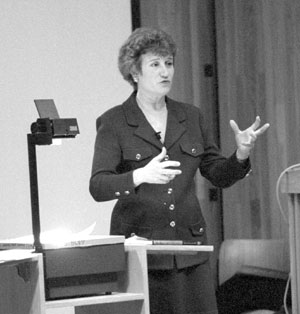|
HOME | SEARCH | ARCHIVE |
|
Coping with job burnout
A pioneer explains its causes, and strategies for renewal
![]()
By Diane Ainsworth, Public Affairs
| |  Christina Maslach talks to staff about job burnout. Noah Berger photo |
25 April 2001
|
How do you rate on the “Maslach Burnout Inventory?” Overworked? Overwhelmed? Fed up? Catching too many colds? Becoming cynical about work? Shifting from an attitude of doing your best, maybe a little beyond the call of duty, to handling only the bare essentials? If you’ve answered yes to these questions, you’re suffering from job burnout. “Burnout is a response to chronic job stressors,” said psychology professor and Vice Provost of Undergraduate Education Christina Maslach, a pioneer in the field of job burnout. “It’s hard to deal with chronic job stressors — things in the environment that trigger a physiological state of fight or flight — because the stressors are there, but they’re sometimes not high-level enough to even notice how much they’re taking out of you,” she said. “Instead there is a kind of gradual erosion that leads to the exhaustion, cynicism and ineffectiveness of burnout.” The term “job burnout” was not invented but emerged from the care-giving professions. But the stressors leading to job burnout, which accumulate with time, can become debilitating if employees do not recognize and find ways to cope with them. “A stressful job environment can be toxic,” Maslach told staff, faculty and students at a noontime talk hosted by the Berkeley Staff Assembly. “There are enormous physical consequences, particularly with chronic stress.” The author of several books on the subject — including “The Maslach Burnout Inventory,” the most widely used measurement of job burnout both nationally and internationally — Maslach has worked with various organizations to bring about organizational renewal in the fast-paced world of work today. “The hallmark of burnout is cynicism, because once that sets in, it’s really hard to change,” she said. “Cynicism changes how people work, how they feel about themselves and how they interact with others.” In one of her books, “The Truth About Burnout,” Maslach draws an analogy between workplace burnout and “psychological ergonomics.” “When we examine job burnout, we can ask if there is a good fit between the job environment and the individual,” she said. “Does the environment support people’s motives and feelings and goals … and make them feel really excited about work? Or is there a mismatch between the individual and the work environment?” Good fits promote engagement with work; mismatches lead to burnout. “We’ve found that there are six areas in which that fit or mismatch makes a difference,” she said. “Workload, control, reward — and as it turns out, recognition is the most important part of that — community (your immediate work community), fairness and values.” A mismatch will occur when any one of these external factors, such as workload or control over work, is out of whack with the worker’s expectations and capabilities. “When an employee feels there is a lack of control over the job, that individual interprets the situation as having little opportunity to use creativity and problem-solving abilities,” she said. “There’s no control over the process of achieving outcomes for which he or she is being held accountable.” With insufficient rewards, the individual will experience a devaluation of both the work and workers around him or her. Likewise, she said, the breakdown of community will result in a loss of positive connections with others, and will produce chronic and unresolved conflict with others on the job. Once the mismatches have been identified, Maslach will work with the organization to develop relevant interventions that address them. She will also use the positive indicators of job satisfaction, like engagement, and the high scores on control and sense of community in the Berkeley case, to help organizations find ways of renewing themselves. The process takes time, she cautioned. “There are no quick fixes to burnout,” she said. “And any plan for organizational change will always involve a phase of things getting worse before they get better. “But in working with the organization, it’s important to identify what people really feel positive about in their work and focus on those aspects as ways to alleviate burnout,” she said. “It’s not useful to focus only on the negatives of burnout. We’re looking for ways of building engagement in work again.”
Burnout has three dimensions or stages, she said: an individual’s stress response, which involves exhaustion; cynicism toward the job; and a negative self-evaluation, which usually reflects low self-esteem.
Home | Search | Archive | About | Contact | More News
Copyright 2000, The Regents of the University of California.
Produced and maintained by the Office of Public Affairs at UC Berkeley.
Comments? E-mail berkeleyan@pa.urel.berkeley.edu.